Table of Contents
- Definition and Significance of KRIs
- Why Mid-Sized Organizations Need KRIs
- Key Risk Indicators vs. Traditional Risk Metrics
- The Benefits of Using Key Risk Indicators in Industry-Specific Contexts
The Primary Purpose of Key Risk Indicators
How KRIs Help Companies Identify Emerging Risks
Characteristics of Good Key Risk Indicators
- 1. Relevance to Business Objectives
- 2. Measurability and Quantifiability
- 3. Timeliness and Predictive Power
- 4. Actionability and Clarity
- 5. Consistency and Reliability
- 6. Ease of Communication and Understanding
- 7. Scalability for Future Needs
- 8. Benchmarking Against Industry Standards
Difference Between KRIs and KPIs
Roadmap to Implementing Key Risk Indicators
- Step 1: How to Identify Key Risk Indicators
- Step 2: How to Select the Relevant Key Risk Indicators
- Step 3: How to Set Key Risk Indicator Thresholds
- Step 4: How to Monitor Key Risk Indicators
- Step 5: How to Plan for Risk Mitigation
Challenges of Developing Key Risk Indicators
Role of Technology in Managing Key Risk Indicators
- Automates Data Collection and Integration
- Enables Real-Time KRI Monitoring and Alerts
- Facilitates Data-Driven Decision-Making
- Streamlines KRI Reporting and Compliance
- Improves Team Collaboration and Communication
- Supports Continuous Improvement and Agility
Introduction
Many mid-sized organizations fail to give due consideration to risk factors within their operations. Businesses must take a proactive risk management approach to ensure stability and growth. This is particularly critical for the banking, finance, insurance, healthcare, and manufacturing sectors. Regulatory oversight, operational complexities, and market volatility are common in these industries. Yet, mid-sized companies often face unique challenges in managing risk—limited resources, smaller teams, and less access to sophisticated tools can make it harder to stay ahead of emerging threats.
Key Risk Indicators (KRIs), a critical component of risk management, can be helpful here. KRIs enable mid-sized businesses to anticipate potential risks, offering an early warning system that helps prevent issues before they escalate. For companies in the banking and finance sector, this might mean spotting trends that could lead to regulatory breaches. In insurance, Key Risk Indicators can signal exposure to risks in claims or underwriting. Healthcare organizations may use KRIs to monitor patient safety concerns, while manufacturers can track supply chain vulnerabilities and production risks. Unlike traditional risk metrics, KRIs empower teams to respond proactively, using real-time insights to enhance decision-making and strengthen resilience.
This guide offers a structured approach to identifying, implementing, and leveraging KRIs to help mid-sized organizations improve their operational performance. By exploring the core elements of KRIs, such as how they differ from traditional metrics, best practices for implementation, and industry-specific examples, you’ll gain the insights needed to make KRIs a central component of your operational management strategy. Additionally, we’ll discuss a roadmap for implementing KRIs and how technology can support KRI management. By the end of this guide, you will better understand how your team can focus on meeting organizational goals while minimizing risk.
What are Key Risk Indicators?
Key Risk Indicators are metrics that provide early warnings about potential risks that could affect an organization’s performance, objectives, or regulatory standing. Unlike traditional risk metrics that often focus on historical data (e.g., loss events or past incidents), KRIs are forward-looking indicators designed to signal impending risks. This proactive approach enables organizations, particularly mid-sized ones, to detect and address potential issues before they become critical, safeguarding their operational integrity and strategic goals.
Definition and Significance of KRIs
KRIs are metrics that track risk, alerting organizations to changes in their risk environment, from fluctuating market conditions to emerging regulatory pressures. They serve as “red flags” for risk managers, executives, and compliance teams, allowing them to make informed decisions before risks lead to disastrous situations. Resources are often limited in mid-sized companies, and KRIs represent an efficient, targeted way to focus attention and resources on the most pressing threats.
Why Mid-Sized Organizations Need KRIs
Managing risks proactively is crucial for mid-sized companies in highly regulated or operationally intensive sectors to sustain growth and competitiveness. Integrating KRIs into strategic planning empowers growing organizations to bridge gaps in their risk management frameworks because they often lack the extensive budgets or personnel available to larger enterprises. By providing early insights, KRIs help mid-sized firms make agile, informed decisions in response to dynamic environments, safeguarding operational continuity and regulatory compliance.
Key Risk Indicators vs. Traditional Risk Metrics
While both KRIs and traditional risk metrics play a role in a company’s overall risk management strategy, they serve distinct purposes:
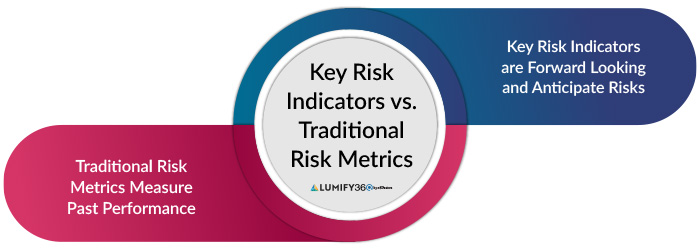
- KRIs focus on anticipating risks by monitoring leading indicators. For example, in banking, a KRI could track loan delinquency trends to predict potential increases in credit risk.
- Traditional Risk Metrics, by contrast, measure past risk events or losses, such as fraud cases in the insurance sector, that have already impacted the organization.
Mid-sized companies in sectors like healthcare, finance, and manufacturing increasingly adopt KRIs as proactive risk management tools, allowing them to address vulnerabilities such as fraud and safety hazards.
The Benefits of Using Key Risk Indicators in Industry-Specific Contexts
- Banking and Finance: KRIs can help monitor credit, market, and operational risks for financial institutions, with indicators such as economic downturn warnings, borrower credit deterioration, or anomalies in trading volumes.
- Insurance: For insurers, KRIs can be critical in assessing underwriting, claims, and compliance risks, providing early signals for spikes in claim frequency or changes in regulatory standards.
- Healthcare: KRIs focus on operational safety and regulatory compliance, with indicators tracking patient incidents, drug administration vulnerabilities, or regulatory shifts affecting patient privacy.
- Manufacturing: KRIs often relate to supply chain disruptions, equipment maintenance, and labor safety protocols, offering early warnings on supply shortages or production delays.
Key Risk Indicators allow businesses to manage risks in a structured and anticipatory way, allowing mid-sized organizations to focus on growth while ensuring that potential threats are monitored and controlled. With the correct KRI tracking in place, businesses can enhance their resilience, better manage regulatory pressures, and respond swiftly to changes in their operating environments.
The Primary Purpose of Key Risk Indicators
The primary purpose of KRIs is to enable organizations to identify, assess, and manage risks before they materialize into issues that could impact their strategic goals. KRIs are essential tools that allow mid-sized organizations to safeguard operations, meet regulatory expectations, and maintain a competitive edge by staying one step ahead of potential challenges.
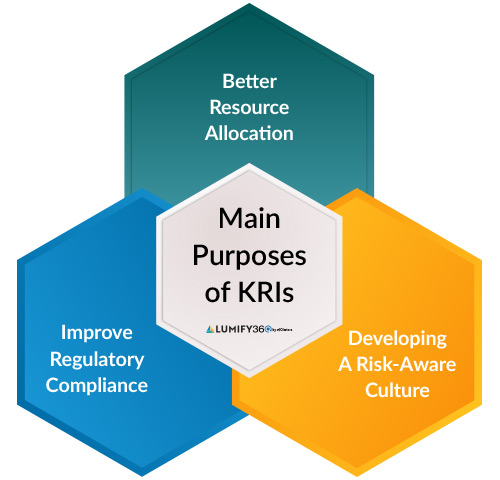
- KRIs enable businesses to allocate resources effectively, prioritizing risks that have the greatest potential to disrupt operations or harm the company’s financial health. For example, a bank may use KRIs to monitor interest rate fluctuations, helping it manage loan portfolios and protect against interest rate risk. In healthcare, KRIs might focus on patient safety metrics to ensure compliance and avoid regulatory penalties.
- KRIs also play an essential role in developing a risk-aware culture within mid-sized organizations. By integrating KRIs into regular reporting and risk discussions, companies can increase awareness of potential risks across teams and departments. Risk awareness encourages proactive behavior among employees, promotes accountability, and aligns staff with the organization’s risk management objectives. For example, a manufacturing company may include KRIs related to machinery maintenance and safety in team meetings, fostering a culture where employees are vigilant about identifying early signs of equipment failure.
- In heavily regulated industries like banking, insurance, and healthcare, meeting regulatory standards is crucial for operational success and protecting the organization’s reputation. KRIs are a fundamental tool for maintaining compliance by helping companies stay aware of any indicators that could lead to non-compliance or violations. For instance, banks might track KRIs related to anti-money laundering (AML) activity to ensure compliance with financial regulations.
How KRIs Help Companies Identify Emerging Risks
KRIs enable businesses to identify and manage risks proactively rather than react to emerging risks. The critical distinction between proactive and reactive risk management lies in how organizations respond to risks:
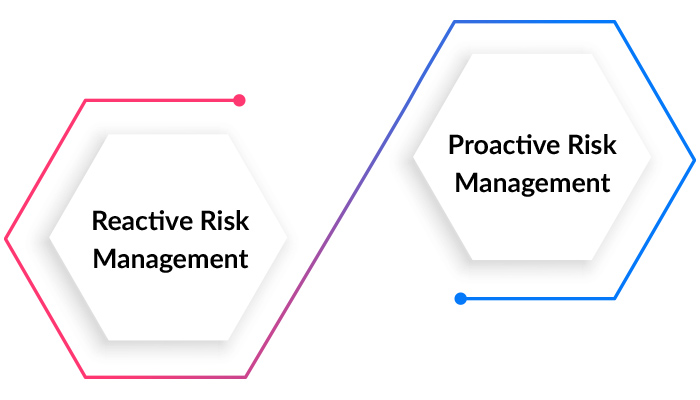
- Reactive Risk Management means responding after a risk event has already occurred. While valuable for understanding past failures, reactive management lacks the forward-looking capabilities required to prevent similar issues from happening again.
- Proactive Risk Management, powered by KRIs, allows organizations to foresee potential threats and take preventive actions. For instance, rather than responding only after regulatory penalties, a financial institution can use KRIs related to compliance activities to identify trends that might indicate future regulatory risks, allowing the institution to adjust policies proactively.
Emerging Risk Identification for Different Industries
Different industries face unique emerging risks, and KRIs should be tailored to each industry to provide specific and actionable early warnings.
- Banking and Finance: In the banking and finance sector, KRIs can track changes in economic indicators, borrower behavior, or fraud patterns that signal emerging credit or operational risks. For example, an increase in non-performing loans (NPLs) can serve as a KRI, alerting a bank to consider credit risk well before they impact the bottom line
- Insurance: Insurance companies can use KRIs to monitor underwriting, claims processing, and regulatory compliance risks. An uptick in claims volume or a rise in payout frequency can serve as early indicators of adverse trends, prompting insurers to adjust underwriting criteria or investigate fraud before losses accumulate.
- Healthcare: In healthcare, KRIs can help organizations identify risks related to patient safety, regulatory compliance, and data security. For instance, increased patient incident reports or deviations in clinical outcomes can indicate potential risks that require immediate attention.
- Manufacturing: Manufacturing companies face risks associated with supply chain disruptions, equipment failures, and workforce safety. KRIs that monitor supplier lead times, maintenance schedules, and accident rates can provide early alerts to issues that might disrupt production or endanger worker safety. For example, increased equipment downtime can serve as a KRI that prompts preventive maintenance before more significant problems arise.
Examples of KRIs
KRIs vary widely by industry and business function and are tailored to measure risks affecting organizational stability and performance. For mid-sized organizations, KRIs are essential for addressing industry-specific threats. The following examples illustrate how KRIs can track emerging risks and strengthen risk management strategies, aligning with each industry’s unique needs.
Banking and Finance KRIs
In the banking and finance industry, KRIs are often centered on credit, liquidity, operational, and regulatory compliance risks. Some common KRI examples in this sector include:
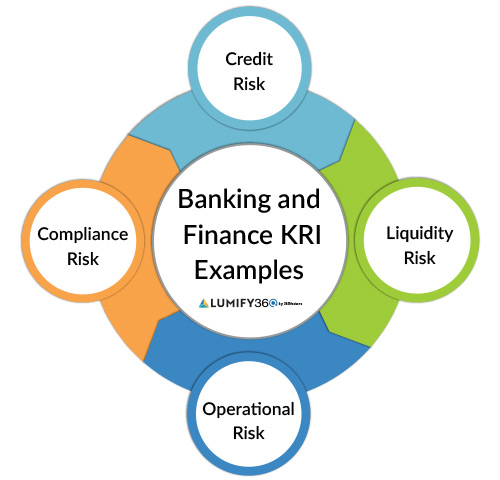
- Credit Risk KRI: Non-Performing Loan (NPL) Ratio
- Liquidity Risk KRI: Liquidity Coverage Ratio (LCR)
- Operational Risk KRI: Fraud Detection Alerts
- Compliance Risk KRI: Regulatory Violation Incidence
Insurance KRIs
For insurance companies, KRIs help manage risks related to underwriting, claims management, investments, and compliance with industry regulations.
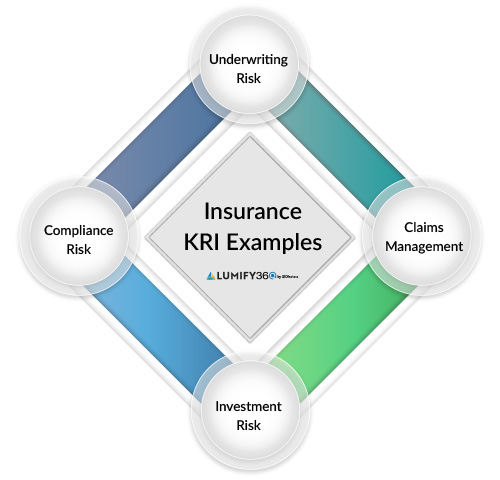
- Underwriting Risk KRI: Claim Payout Ratio
- Claims Management KRI: Claims Frequency Rate
- Investment Risk KRI: Market Value of Investment
- Regulatory Compliance KRI: Complaint Volume
Healthcare KRIs
In healthcare, KRIs are vital for managing risks associated with patient safety, regulatory compliance, cybersecurity, and operational efficiency. Mid-sized healthcare providers benefit from monitoring these indicators to ensure quality care and patient data security.
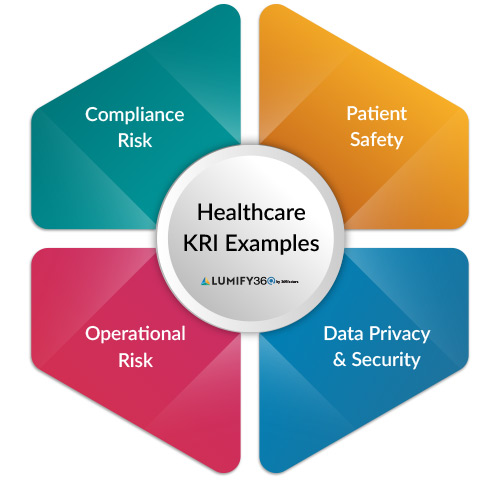
- Patient Safety KRI: Infection Control Rate
- Operational Risk KRI: Patient Waiting Time
- Data Privacy and Security KRI: Unauthorized Access Attempts Prevented
- Regulatory Compliance KRI: Medication Error Rate
Manufacturing KRIs
Manufacturing organizations face unique risks associated with supply chain management, equipment reliability, labor safety, and quality control. KRIs help mid-sized manufacturers anticipate and manage these risks.
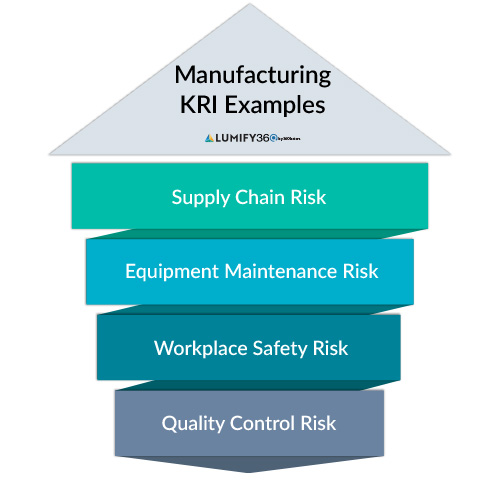
- Supply Chain Risk KRI: Supplier Delivery Timeliness
- Equipment and Maintenance Risk KRI: Machine Downtime Rate
- Workplace Safety KRI: Accident Frequency Rate
- Quality Control KRI: Product Defect Rate
Characteristics of Good Key Risk Indicators
Key risk indicators must be designed with specific qualities to ensure they are reliable, actionable, and aligned with organizational objectives. Mid-sized organizations can maximize the effectiveness of their KRIs by focusing on indicators relevant to their unique risks and operational realities. Some key characteristics that make KRIs robust and impactful in identifying, managing, and mitigating risks are covered below.
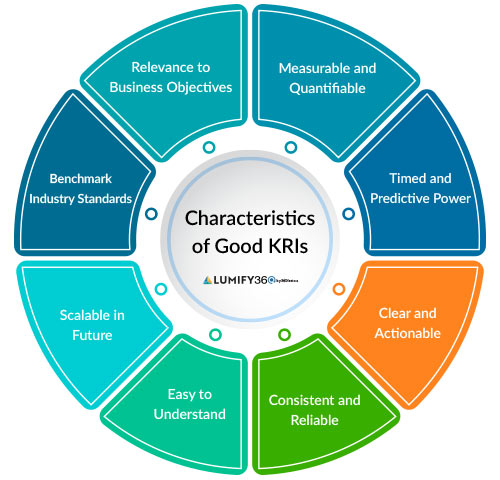
1. Relevance to Business Objectives
A strong KRI directly relates to a business’s strategic goals and primary risk areas. KRIs should be tailored to an organization’s unique risk profile and industry to provide meaningful insights. For example, KRIs in banking and finance should focus on credit and liquidity risks, aligning with maintaining asset quality and regulatory compliance. Similarly, KRIs in insurance should be based on monitoring underwriting and claims risk, which is essential to maintaining profitability.
2. Measurability and Quantifiability
Effective KRIs should be measurable, allowing organizations to track, compare, and analyze risk levels over time. Quantifiable KRIs provide clear numerical values or percentages that help teams make data-driven decisions. In insurance, the ‘Claim Payout Ratio’ shows the proportion of premiums paid out in claims, making it easy to track risk levels. The ‘Defect Rate’ KRI tracks product quality issues for manufacturing businesses, giving them an actionable measure to improve quality control.
3. Timeliness and Predictive Power
Good KRIs should signal risks before they become critical, offering insights in real-time or near-real time. This is essential for proactive risk management, especially in dynamic industries such as healthcare, where monitoring ‘Patient Incident Rates’ can provide timely insights, helping healthcare professionals adjust procedures or safety protocols before incidents escalate.
4. Actionability and Clarity
An effective KRI signals a risk and provides a straightforward course of action for mitigation. Actionable KRIs give teams the information they need to make decisions and address specific risks. In manufacturing businesses, increases in ‘Supplier Delay Rates’ can prompt procurement teams to explore alternate suppliers, ensuring continuity of production without relying on delayed shipments.
5. Consistency and Reliability
For KRIs to be helpful in long-term risk management, they must deliver consistent and reliable data. KRIs should be monitored using standardized criteria and methods, enabling organizations to trust the accuracy of their indicators. A good example in insurance is tracking ‘Claims Frequency’ consistently across reporting periods, which helps insurers detect genuine trends rather than anomalies, allowing for more accurate underwriting decisions.
6. Ease of Communication and Understanding
KRIs must be easy for stakeholders to understand and interpret. KRIs with clear definitions and straightforward metrics foster organization-wide awareness and action more effectively. In healthcare, a ‘Medication Error Rate’ KRI should be communicated so that the entire healthcare staff can understand, prompting actions to reduce such errors and improve patient safety. For banking institutions, the ‘Liquidity Coverage Ratio’ should be explained in simple terms so all relevant teams grasp its importance in meeting short-term obligations.
7. Scalability for Future Needs
A robust KRI framework can adapt to organizational growth and changing risk landscapes. Scalable KRIs help mid-sized organizations ensure that their risk monitoring remains relevant as the business evolves. For a growing manufacturer expanding its supply chain, the ‘Supplier Lead Time’ KRI helps assess risks with new suppliers, keeping the organization’s risk profile current. Growing insurance businesses can look at the ‘Customer Complaint Rate’ KRI to track region-specific complaints, allowing the organization to address customer service challenges in new areas.
8. Benchmarking Against Industry Standards
Benchmarking KRIs against industry standards or competitors provides additional context for assessing risk levels. By comparing their KRIs to industry norms, mid-sized organizations can understand where they stand regarding risk exposure and take necessary actions to align with best practices. In healthcare, patient incident rates can be compared against industry benchmarks to assess whether a healthcare organization’s patient safety practices meet acceptable standards. Similarly, insurers can benchmark the ‘Loss Ratio’ KRI to understand how their claims performance compares with industry averages, adjusting underwriting policies if needed.
Difference Between KRIs and KPIs
While Key Risk Indicators and Key Performance Indicators are critical tools for measuring various aspects of organizational health, they serve distinct purposes and address different aspects of business strategy.
Roadmap to Implementing Key Risk Indicators
Implementing KRIs involves more than simply selecting a few risk metrics. It requires a structured, strategic approach to effectively identify, select, monitor, and respond to risks. A well-designed roadmap provides a comprehensive framework to help organizations implement KRIs that align with their goals and proactively manage potential threats.
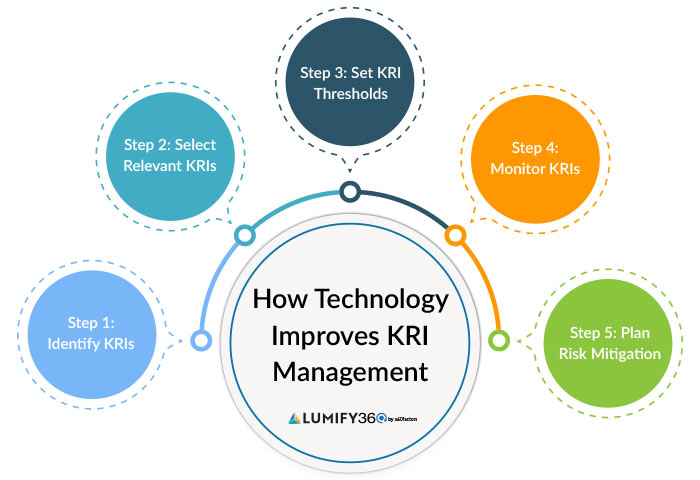
Step 1: How to Identify Key Risk Indicators
Organizations must identify KRIs that are most relevant to their industry, operations, and strategic objectives. Identifying effective KRIs requires thoroughly understanding an organization’s risks and how they impact performance and compliance. This can be achieved through the following efforts.
- Businesses must conduct risk assessment meetings with cross-functional teams to gather insights on potential risks from various perspectives, such as finance, operations, compliance, and IT.
- Businesses can review past incidents or issues to pinpoint recurring or significant risks. Analyzing past events like financial losses, operational delays, or compliance breaches offers valuable indicators that could serve as the building blocks for future KRIs.
- Businesses can also use benchmarking to identify risks common in the industry—such as credit risk in banking, regulatory compliance in healthcare, or supply chain risks in manufacturing—to build a foundation for determining relevant KRIs.
- By engaging key stakeholders, such as senior leadership, risk managers, and compliance officers, organizations can identify the right KRIs for their business.
Step 2: How to Select the Relevant Key Risk Indicators
After identifying potential KRIs, organizations must refine the list by selecting the most relevant and impactful risk indicators. Not every identified risk becomes a KRI, and focusing on the most critical risks keeps the process manageable and effective.
- Businesses must ensure that selected KRIs support their strategic goals. For example, a healthcare provider focused on patient safety should prioritize KRIs related to infection control and regulatory compliance.
- KRIs should reflect the organization’s risk appetite, which varies by sector. For example, a mid-sized bank with a conservative risk appetite may focus on credit risk indicators, while a manufacturing company may focus on supply chain continuity KPIs.
- Selecting KRIs that can be reliably measured and easy to report is vital. Overly complex KRIs can burden the organization and may not deliver clear insights. For instance, a manufacturing KRI that measures product defect rate should have a straightforward calculation method and available data sources.
- KRIs should provide insights into emerging risks, helping the organization act proactively. Purely retrospective indicators, like past revenue losses, may not provide timely insights, whereas indicators like customer complaint rates can serve as early warnings.
Step 3: How to Set Key Risk Indicator Thresholds
It is essential to set appropriate thresholds for each KRI. These thresholds act as triggers, signaling when a risk has reached a level that requires attention or intervention.
- Business leaders must determine a baseline level for each KRI based on historical data or industry averages. This baseline acts as a reference point, making detecting deviations that indicate growing risk levels easier.
- Risk tolerance levels should also be categorized based on severity. For instance, in banking, a KRI for credit risk might have different levels for “acceptable,” “warning,” and “critical” thresholds. These levels help prioritize appropriate response actions based on the intensity of risk.
- KRI thresholds should be adjusted periodically, particularly in a volatile industry like finance, where regulatory standards and market conditions frequently shift. Updating thresholds ensures that the KRI system remains relevant.
- Businesses can also set up automated alerts when thresholds are breached. Alerts help identify issues immediately, allowing the organization to respond faster and potentially prevent negative impacts.
Step 4: How to Monitor Key Risk Indicators
Continuous monitoring of KRIs is essential for effective risk management. An organization’s KRI system should include reliable processes for ongoing tracking and clear reporting mechanisms that make data accessible to decision-makers.
- Technology makes it easy to automate KRI tracking, reducing the manual effort required to collect and update data. Automated dashboards can display real-time KRI information, providing an at-a-glance view of current risks.
- Business leaders must establish regular reporting intervals, such as monthly or quarterly, to update stakeholders on KRI status.
- Monitoring KRIs over time enables organizations to identify trends that indicate escalating risks or repeated issues. For instance, a consistent increase in healthcare infection rates could highlight potential lapses in hygiene practices.
- The KRI data should be easily accessible to relevant teams and leaders across the organization. This fosters a risk-aware culture and ensures decision-makers are fully informed of potential threats.
Step 5: How to Plan for Risk Mitigation
When KRIs indicate elevated risks, organizations must be prepared with appropriate mitigation strategies. A structured approach to risk mitigation helps manage threats effectively and reduces the potential impact on operations or financial health.
- An action plan should be created for each KRI that outlines the steps to take when thresholds are breached. For example, a manufacturing company facing supplier delays might consider alternative sourcing strategies to prevent production stoppages.
- Clear escalation procedures should outline when and how to involve senior management. For instance, if a critical financial KRI in a bank’s portfolio breaches a threshold, the risk management team might escalate the matter to the Chief Risk Officer.
- Specific individuals or teams should be designated to manage each KRI, ensuring accountability and clarity in response efforts. Consider healthcare, where infection control teams may be responsible for KRIs related to hygiene and patient safety while finance teams manage budget-related KRIs.
- Lastly, businesses should conduct a thorough review to assess the effectiveness of the response and identify areas for improvement after each incident. This approach allows the organization to refine its mitigation strategies and enhance the KRI system over time.
Challenges of Developing Key Risk Indicators
Organizations switching to a KRI-based risk management approach often encounter several obstacles, such as data accessibility, accuracy, relevance, organizational alignment, and resource constraints. Addressing these challenges head-on helps ensure the KRI framework is reliable, actionable, and aligned with the organization’s risk appetite.
- One of the biggest challenges is identifying KRIs that are genuinely relevant to the organization’s risk profile. Organizations may struggle to define KRIs that are specific enough to be actionable and broad enough to capture emerging risks.
- Effective KRIs rely on accurate, timely data. However, obtaining high-quality data can be difficult, especially for mid-sized organizations that lack robust data management infrastructure or automated data collection systems.
- Setting suitable thresholds for each KRI is critical, but it can be challenging to determine the exact point at which an indicator signals an actionable risk. Incorrectly set thresholds can lead to false alarms or overlooked risks, completely undermining the KRI system’s effectiveness.
- Confusion between KRIs and KPIs can lead to developing metrics that do not accurately measure risk. While both KRIs and KPIs are valuable, using KPIs in place of KRIs can leave an organization vulnerable to undetected risks.
- The KRI system must be aligned throughout the organization to be effective. Misalignment between departments or lack of executive support can prevent KRIs from effectively integrating into decision-making processes.
- Mid-sized organizations may face resource constraints that make it challenging to monitor, review, and update KRIs as needed continuously. A lack of dedicated staff or technology for ongoing KRI management can lead to outdated or irrelevant indicators, reducing their predictive power.
- Risk environments are constantly changing, especially in industries like banking, healthcare, and manufacturing, where regulatory shifts, market dynamics, and operational challenges can create new risks or modify existing ones. If KRIs are not adjusted to capture new and shifting risks, staying ahead of emerging threats can be difficult.
Role of Technology in Managing Key Risk Indicators
Technology can play a vital role in enabling organizations to manage KRIs effectively. For growing organizations in high-stakes industries, technological tools provide scalable solutions to monitor risks accurately and respond proactively. Leveraging technology not only streamlines KRI management but also enhances the overall resilience and agility of the organization.
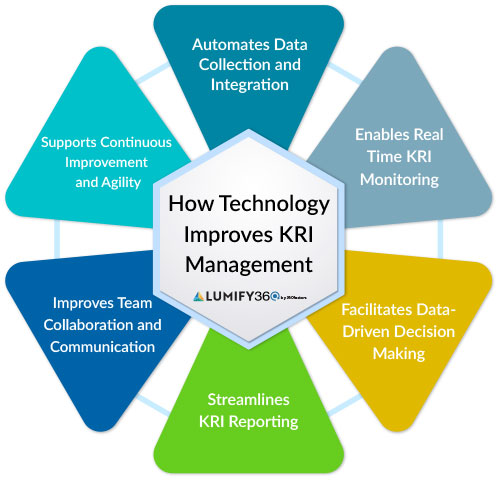
Automates Data Collection and Integration
The primary benefit of technology in KRI management is the automation of data collection. For many organizations, the manual process of gathering data can be time-consuming, prone to errors, and delays KRI management. Automation ensures that data is collected accurately and consistently across various business units, reducing the burden on employees and minimizing the risk of data gaps.
Enables Real-Time KRI Monitoring and Alerts
Without technology, it is tough for organizations to monitor KRIs in real time, impacting their ability to detect potential issues before they escalate. Real-time monitoring allows for instant awareness of KRI thresholds that have been breached, enabling risk managers to act quickly.
Facilitates Data-Driven Decision-Making
Technology enhances the ability of organizations to make informed, data-driven decisions. Instead of relying solely on past experiences or subjective assessments, teams can leverage KRI data to guide decision-making processes with quantitative insights. Advanced analytics tools within KRI platforms can identify trends and patterns over time, highlighting risk areas that may not be immediately apparent.
Streamlines KRI Reporting and Compliance
In highly regulated industries like banking and healthcare, KRI reporting and compliance are crucial, and technology simplifies the process by generating and storing compliance reports with minimal effort. Automated reports reduce the administrative burden, save time, and ensure that documentation is thorough and readily available for audits or regulatory reviews.
Improves Team Collaboration and Communication
Effective risk management requires input and action from various departments, and technology facilitates this collaboration by making KRI data accessible to all relevant stakeholders. Advanced risk platforms provide a centralized space where teams can access, monitor, and respond to KRI data, improving cross-functional communication and alignment.
Supports Continuous Improvement and Agility
Risks constantly evolve, and technology enables organizations to improve their KRI frameworks continuously. With automated data analysis and trend monitoring, organizations can refine their KRIs over time to stay responsive to new risks or shifts in business priorities. Good technology platforms can scale to accommodate more KRIs as mid-sized organizations grow, allowing new data sources and increased data volume to keep the KRI framework responsive and effective.
Conclusion
Growing, mid-sized organizations in the banking, insurance, healthcare, and manufacturing sectors face unique and evolving risks, and they cannot remain indifferent to the probability of such risks materializing. It is essential to use a KRI framework to proactively identify, assess, and respond to these risks before they impact the organization. Organizations can significantly enhance their risk management strategy by implementing well-defined KRIs tailored to their industry and business objectives, promoting operational resilience and long-term stability.
With the right KRIs in place, decision-makers gain real-time insights into emerging risks, empowering them to take preventative action rather than merely reacting to incidents after they occur.
Integrate Technology for KRI Success
Businesses should adopt technology to maximize the impact of KRIs. Advanced KRI software allows organizations to automate risk data collection, enable real-time risk monitoring, and streamline the risk management process. Technology makes KRI data accessible and facilitates collaboration across teams, ensuring all stakeholders are aligned in managing and mitigating risk.
Build a Proactive Risk Culture
KRIs are critical in fostering a culture of risk awareness and proactive decision-making. By consistently tracking and reviewing KRIs, organizations can remain adaptable, refine their risk frameworks, and enhance their overall resilience. In doing so, they protect their current assets and operations and set a strong foundation for sustainable growth.
Take the Next Step
Ready to enhance your risk management with tailored KRIs? Discover how our KRI solution can empower your team to make data-driven, proactive decisions that protect and strengthen your organization. Contact us for a demo to explore how our risk management solutions can help you confidently manage risks.
- Explore Lumify360: Discover how our platform can meet your unique business needs.
- Request a Demo: See Lumify360 in action and learn how it can elevate KRI management.
